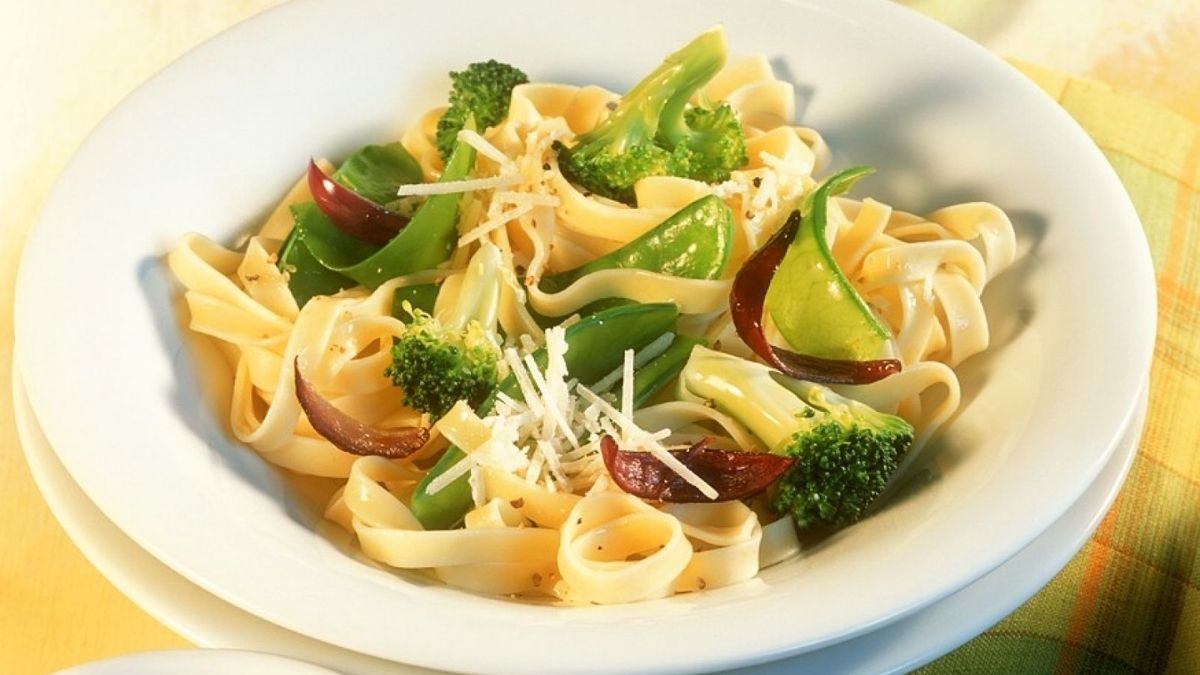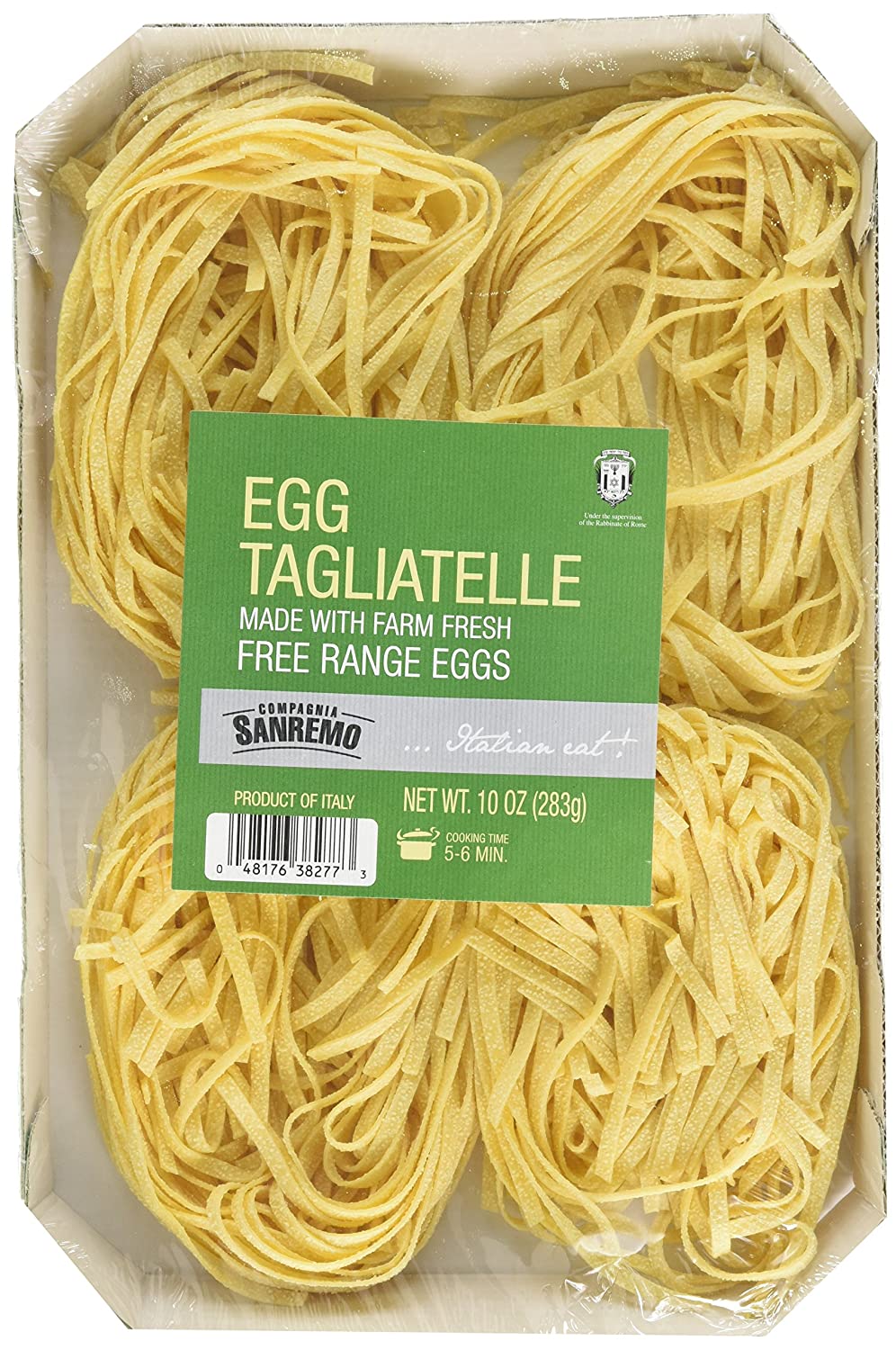Tagliatelle (pronounced Utah-lya-tell-eh) is a popular and delectable pasta shape in Italian cuisine. They are distinctive from Bologna, where the razor, or pasta ladies, handcraft tagliatelle and serve them with the traditional ragù sauce. Although it is a traditional Emilian dish, tagliatelle is also famous in other parts of Italy.
They are served with various toppings such as mushrooms, truffles, or a simple, fresh tomato sauce. On April 16, 1972, the Brotherhood of the Tortellini and the Italian Academy of Cuisine registered the original “tagliatelle di Bologna” recipe and dimensions with the Bologna Chamber of Commerce, Craft Trades, and Agriculture. A single strand of tagliatelle should be 8 millimeters broad after cooking or approximately 7 millimeters when raw.
Tagliatelle is pasta prepared with wheat flour and egg with wide, flat noodles. Tagliatelle is a popular pasta dish in Italy’s Emilia Romagna and Marche regions. The word “tagliatelle” is derived from the Italian verb “tagliare,” which means “to cut.” It’s traditionally served with a beef sauce called bolognese. Uova e Formaggio (eggs and cheese—similar to a carbonara) and simply Pomodoro e Basilico are two other classic tagliatelle pasta dishes (a basic tomato sauce with basil). Tagliolini is a cylindrical variant of tagliatelle that differs from flat tagliatelle.
What is Tagliatelle?
Semolina, a type of coarse flour manufactured from durum wheat, is used to make tagliatelle, a long, flat, ribbon-shaped egg pasta. The word tagliatelle is derived from the Italian verb tagliare, which means “to cut” and roughly translates as “chop up.” This is because tagliatelle is usually produced by rolling the dough into flat sheets and then cutting it into ribbons with a kitchen knife. Straight ribbons or curled into a nest are both available. Bologna, the capital of the Emilia-Romagna region in northeastern Italy, is regarded as tagliatelle’s birthplace. Bologna is also the birthplace of the Bolognese sauce, a substantial, slow-cooked meat sauce traditionally served with tagliatelle.
Tagliatelle alla boscaiola, with porcini mushrooms and a creamy or tomato-based sauce; tagliatelle al Salmone, with cream and chunks of smoked salmon; and paglia e fieno, which combines green and yellow tagliatelle (the green is made by adding cooked spinach to the dough) and is served in a cream sauce with onions, prosciutto, peas, and olive oil. Tagliatelle is also served with uova e formaggio, an egg and cheese sauce, and pomodoro e basilico, a basic tomato and basil sauce.
According to the Italian Academy of Cuisine, the width of tagliatelle ribbons should be 6.5 to 7 millimeters before cooking, according to the Italian Academy of Cuisine, which works out to roughly 8 millimeters after cooking. The ribbons are approximately 1 millimeter thick. Because it’s produced with coarsely ground semolina, the texture of the pasta used to make tagliatelle is rough, giving the noodles a porous characteristic that allows richer, heartier sauces to stick to them.
Are Fettuccine and Tagliatelle the Same Thing?
Fettuccine is a similar pasta form that is sometimes compared to tagliatelle. They’re also similar in that they’re both strand pasta sliced into long, flat ribbons. The fundamental distinction is that tagliatelle contains egg and semolina, whereas fettuccine does not, and Tagliatelle ribbons are also slightly wider than fettuccine. Another distinction is that tagliatelle is more likely to be fresh, whereas fettuccine is always dry. Due to their similarity, fettuccine could be used in place of tagliatelle.
Italian Egg Tagliatelle Pasta
- The Wise choice of the best grains, the slow grinding, the long drying, and a skilled handicraft guarantee a range of really biological products
- Designed for those consumers who take care of their health and of the environmental defense; such results Can only be obtained using natural methods and techniques
- Manufactured in Italy
- Specialty Egg Pasta
How to Cook Tagliatelle?
Cooking tagliatelle is as easy as simmering it in salted water until it reaches the al dente stage. It takes different amounts of time depending on whether you’re using fresh or dried pasta. Fresh pasta cooks fast, taking two to four minutes, depending on thickness. To ensure that it does not overcook, check it after two minutes. Cooking time for dried tagliatelle to reach al dente varies between 7 and 10 minutes.
Tagliatelle is one of the plainest pasta to prepare at home. You can use a pasta machine to roll out the dough sheet, then roll it loosely into short folds like a rug, adding a slight coating of flour in each fold to keep the pasta from sticking. Then, cut it into ribbons about 1 centimeter wide, or a little less, once it’s rolled with a sharp knife. Cook it right away or refrigerate it for up to 24 hours after cutting.
What is the Texture of Tagliatelle?
Tagliatelle has a long, flat shape and a rough texture compared to other pasta types. It works better with thicker sauces in some circumstances, but it can also work with thin sauces. One of the key advantages of this style of pasta is the extensive range of sauces it may work with. When you drop your noodles into boiling water for the first two minutes, they’re covered in a sticky film of starch. If you don’t mix the noodles constantly for the first two minutes, they’ll stick to each other and stay stuck since they’ll cook together. Keep stirring.
Is Tagliatelle the Same as Egg Noodles?
While both are produced from egg pasta dough (known as ‘pasta all’uovo’ in the Italian dialect) and are long, flat, and (usually) straight in shape, tagliatelle is 6mm broad (as defined by Bologna’s chamber of commerce), and pappardelle are typically 2-3cm wide. Both egg noodles and pasta are made from unleavened dough. Here are a few distinctions: Ingredients: The primary distinction between egg noodles and pasta is that the former must be made with eggs.
Conclusion
Tagliatelle (pronounced “talk-ya-TELL-eh”) is a long, flat, ribbon-shaped pasta that originated in the Italian regions of Marche and Emilia-Romagna. It comes in both fresh and dried versions, and it’s commonly served with a meat sauce like Bolognese. If you can’t get tagliatelle, fettuccine, or pappardelle, ribbon kinds of pasta are suitable substitutes. Although it is narrower, you may use linguine as a last resort, and the strands are thicker than tagliatelle. Depending on the region of Italy, a thinner variation of tagliatelle is known as tagliolini, taglierini, or occasionally tajarin. It’s prepared with semolina and egg, and it’s cut into smaller ribbons, about 3 millimeters wide, like tagliatelle.
Whether the tagliatelle is fresh or dried, they are boiled in salted water for 5-8 minutes. Because the changes in the dough and the processing make it impossible to determine a single cooking time, it’s necessary to sample them before draining. Emilian women continue to stretch out dough with a rolling pin until it is practically translucent, then fold and cut the sheets into long, thin strips hung up to dry. These are rapid movements derived from ancient knowledge.



